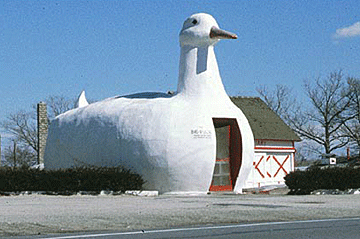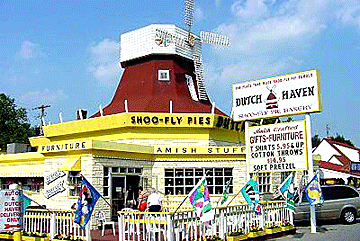|
Antiques Along the
Highway
by Bob Brooke
 Structures
like the Shoe House sprang up in the 1940s and 1950s along roads like
the Lincoln Highway, the first automobile road to cross the United
States. Structures
like the Shoe House sprang up in the 1940s and 1950s along roads like
the Lincoln Highway, the first automobile road to cross the United
States.
Mahlon Haines, also known as “The Shoe Wizard” and founder of a shoe
manufacturing and sales empire in central Pennsylvania and northern
Maryland that included more than 40 stores, built the Shoe House in 1948
at the age of 73. He had a flair for outlandish advertising, calling
himself "Colonel" Haines and offering money to smokers if they promised
to quit. He also gave money to those who could identify him in a crowd.
But the shoe house was his ultimate gimmick.
Located on Shoe House Road, three miles east of York, Pennsylvania, off
Old Lincoln Highway (now PA Route 462), the 48-foot-long by 25-foot-high
Shoe House, constructed of stucco over a wood and wire framework,
featured seven rooms–a honeymoon suite (the living room), three
bedrooms, two baths, and a kitchen–but there was really only enough
space for couple. The shoe motif is everywhere, including a
stained-glass window with an image of Haines in it on the front door.
 At
first, Haines offered the house to elderly couples, who could live for a
weekend like a "kings and queens" at Haines' expense. After 1950, he
offered it to honeymooners who had a Haines shoe store in their town.
After his death, it served as an ice cream parlor but deteriorated until
Annie Keller, Haines' granddaughter, bought it at auction. She restored
it, briefly operating it as a tourist attraction. Ruth Miller purchased
the Shoe House in 1995 and operated it as an antique shop. At
first, Haines offered the house to elderly couples, who could live for a
weekend like a "kings and queens" at Haines' expense. After 1950, he
offered it to honeymooners who had a Haines shoe store in their town.
After his death, it served as an ice cream parlor but deteriorated until
Annie Keller, Haines' granddaughter, bought it at auction. She restored
it, briefly operating it as a tourist attraction. Ruth Miller purchased
the Shoe House in 1995 and operated it as an antique shop.
When Haines built his Shoe House, the Lincoln Highway was already 35
years old. Entrepreneurs like Haines saw the road as a great marketing
opportunity and erected larger than life structures that looked like
what they advertised or sold.
The idea for a coast-to-coast highway originated with Carl Fisher,
founder of the Prest-O-Lite Company, maker of the first dependable
automobile headlights. However, he’s better known for developing the
Indianapolis Speedway and then paving it with bricks, and later gained
notoriety for developing Miami Beach out of swampland in south Florida.
In September 1912 Fisher presented his idea to the leaders of the
automobile industry, who enthusiastically adopted it. Their acceptance
of a transcontinental route came not only from the chance to sell more
cars, but also from a sense of adventure and an honest desire to get
Americans out on the road. Travel between cities, even on the new
Lincoln Highway, was mostly on gravel or dirt roads.
In 1913, Fisher established the Lincoln Highway Association (LHA) "to
procure the establishment of a continuous improved highway from the
Atlantic to the Pacific, open to lawful traffic of all description
without toll charges . . . in memory of Abraham Lincoln." The plan
linked existing roads into a 3,389-mile cross-country highway through 12
states from New York City to San Francisco. The organizers hoped local
governments would improve their own sections although this took quite a
while.
 From
all across the country, people paid $5 to join the association. Many
ordered souvenirs–pennants, “official" radiator emblems, guidebooks and
maps. Other companies also got in on the act, offering Lincoln Highway
cigars, sheet music, automobile tires, and gasoline pumps. In fact,
anyone with a product to sell seemed to borrow the Lincoln Highway name. From
all across the country, people paid $5 to join the association. Many
ordered souvenirs–pennants, “official" radiator emblems, guidebooks and
maps. Other companies also got in on the act, offering Lincoln Highway
cigars, sheet music, automobile tires, and gasoline pumps. In fact,
anyone with a product to sell seemed to borrow the Lincoln Highway name.
The LHA marked the Lincoln Highway with red,
white, and blue emblems, each with a large L. At first, they simply
painted the colors on telephone poles, but soon erected porcelain
enameled steel signs to mark the route. Finally, in 1928, the Boy Scouts
of America erected cement posts with bronze medallions bearing a profile
of Lincoln and the highway’s familiar red, white, and blue emblem every
mile along the road.
To attract the attention of passing motorists, entrepreneurs all across
the country set out building fantasy structures which resembled
lighthouses, teapots, ducks, windmills–and, yes, shoes.
 Dutch
Haven is one of these rare mid-20th-century roadside structures, easily
identifiable by its tall Dutch windmill. Original owners, Roy and Alice
Weaver constructed the windmill around a previous building in 1946 to
offer Pennsylvania Dutch cooking and a gift shop with souvenirs. Dutch
Haven’s current owner, Paul Stahl, bought the business in 1991 and now
offers crafts for sale in its windmill-topped building along with its
famous shoo-fly pie, a traditional Pennsylvania Dutch dessert. Dutch
Haven is one of these rare mid-20th-century roadside structures, easily
identifiable by its tall Dutch windmill. Original owners, Roy and Alice
Weaver constructed the windmill around a previous building in 1946 to
offer Pennsylvania Dutch cooking and a gift shop with souvenirs. Dutch
Haven’s current owner, Paul Stahl, bought the business in 1991 and now
offers crafts for sale in its windmill-topped building along with its
famous shoo-fly pie, a traditional Pennsylvania Dutch dessert.
The SS Grand Viewpoint Hotel, west of Bedford, Pennsylvania, was a river
steamer built along the Lincoln Highway in the Allegheny Mountains.
Herbert Paulson, Dutch immigrant who left Holland in the early years of
the 20th century to work as a twin dye maker in the mills in Pittsburgh,
built the hotel in the mid-1920s above the Grandview lookout. In 1931,
Paulson decided to enlarge his hotel and decided on a ship motif. The
unusual structure required 63.5 tons of steel costing $125,000 borrowed
at 16 percent interest. The contractors went broke digging down 32 feet
to find bedrock into which to “anchor” the ship. The result was an
authentic steamer, complete with observation decks ringed with life
preservers and telescopes for enjoying the view. Paulson called his
upstairs rooms First Class and his budget-priced rooms on the lower
floors Second and Third Class. The employees living on the bottom floor
joked that they lived in steerage. Today, it stands quietly awaiting
it’s next moment in history.
 The
way people travel has changed greatly since the Lincoln Highway was a
collection of muddy roads. People once traveled for the sake of
traveling. They looked forward to staying in tourist cabins, to eating
in diners, to seeing the attractions along the way, and to buying
souvenirs in gift shops. The
way people travel has changed greatly since the Lincoln Highway was a
collection of muddy roads. People once traveled for the sake of
traveling. They looked forward to staying in tourist cabins, to eating
in diners, to seeing the attractions along the way, and to buying
souvenirs in gift shops.
Along the Lincoln Highway, just east of Exton, Pennsylvania, stands what
remains of Williams’ Deluxe Tourist Cabins, built by Leon H. Williams in
1937. Over the years, he added more of them but sold the complex in
1964, when they became the Tudor Motor Inn. Today, they’re boarded up
and waiting for someone to develop the land. Fortunately, they’ve been
placed on the National Register of Historic Places.

Several miles down the road to the east stands the Frazer Diner, a 1940
O. Mahoney diner. It’s been completely restored inside and out and
serves good old-fashioned diner food. Sitting at the counter is like
being taken back in time to the 1940s.

The coffeepot, also along the Lincoln Highway west of Bedford, is
another of these unique roadside eateries. It used to be covered with
metal and nicely landscaped. Today, it’s painted red and white and is no
longer sheathed in metal. During its lifetime, it served as a lunch
stand, Greyhound station, and most recently, a bar, but it's been closed
for a long time.
 The
world's largest teapot was originally built as a Hires Root Beer barrel
advertisement. Wilfred Devon moved it to Chester, West Virginia, in 1938
and converted to a teapot to attract customers from the newly rerouted
Route 30. At the time, Chester had become a pottery manufacturing
center. Devon served ice cream and other refreshments from the red and
white teapot and sold art ware, pottery, and souvenirs in a building
behind it. It changed owners a few times after being sold in 1947 and
fell into disrepair. The phone company eventually bought the property
and gave the teapot to the residents of Chester, who have since restored
it. The
world's largest teapot was originally built as a Hires Root Beer barrel
advertisement. Wilfred Devon moved it to Chester, West Virginia, in 1938
and converted to a teapot to attract customers from the newly rerouted
Route 30. At the time, Chester had become a pottery manufacturing
center. Devon served ice cream and other refreshments from the red and
white teapot and sold art ware, pottery, and souvenirs in a building
behind it. It changed owners a few times after being sold in 1947 and
fell into disrepair. The phone company eventually bought the property
and gave the teapot to the residents of Chester, who have since restored
it.
Like many antiques and collectibles, the Shoe House, the Chester teapot,
and the Dutch Haven windmill have been lovingly preserved, but other
examples of roadside architecture, falling in the wake of “progress,”
haven’t been so lucky.
<
Back to More Special Features
Next Article >
|
